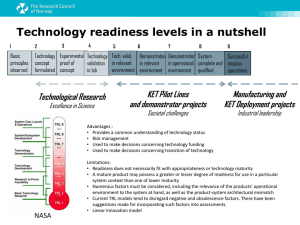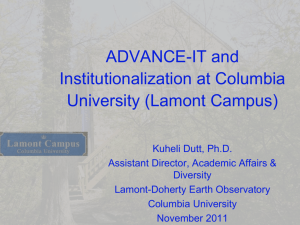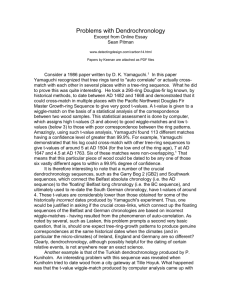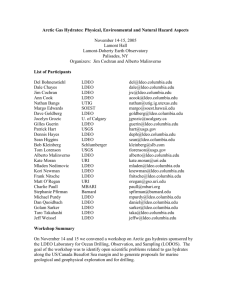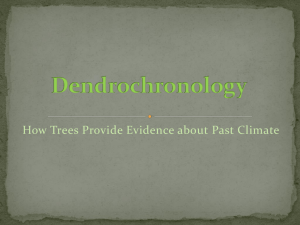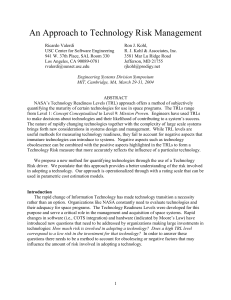Learning from Tree Rings” Earth2Class Workshops for Teachers
advertisement
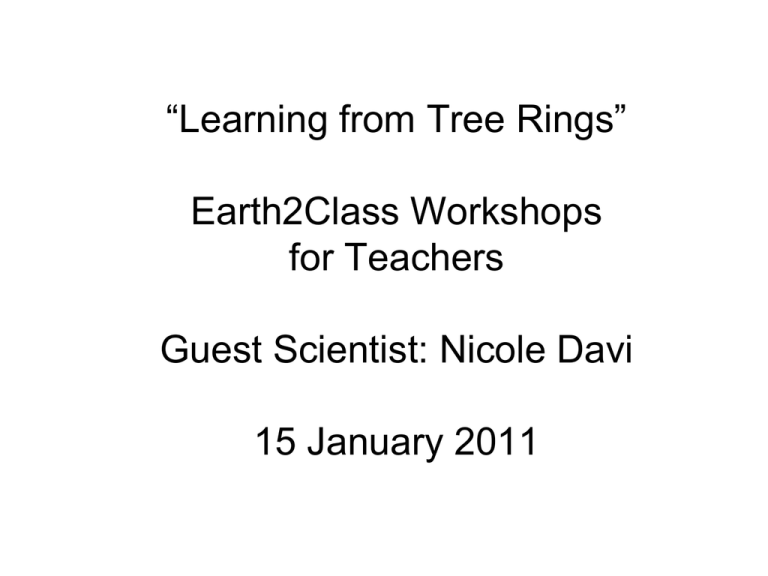
“Learning from Tree Rings” Earth2Class Workshops for Teachers Guest Scientist: Nicole Davi 15 January 2011 Want to understand climate? Ask a tree who was there! DENDROCHRONOLOGISTS at the LDEO Tree-Ring Lab study annual growth rings of old trees to learn about past environmental changes. By combining living and dead wood scientists can extend tree-ring paleoclimatology records back hundreds to thousands of years. http://web.utk.edu/~grissino/ What are tree-rings? • Trees expand in width by the division of cells in a thin layer underneath the bark • Some cells add to the bark, but most add to the wood • These “xylem” cells carry water and minerals from the roots • Only one ring grows each year • Age of a tree can be determined by analyzing rings according to Principles discussed later in this presentation Why does ring width vary? • • • • Environmental factors will cause rings to be narrower or wider. These include: Drought or abundant rainfall Saturated soils Insect, fungus, or other diseases Volcanic eruptions, earthquakes, or other natural disasters Human activities may also affect ring width For example, the impact of solution-brine mining in the Finger Lakes region of New York State is preserved in these tree rings. http://ny.usgs.gov/pubs/fs/fs05797/html2/FS057-97.html Some Basic Principles of Dendrochronology One of the best sources for information about dendrochronology has been created by Dr. Henri D. Grissino-Mayer of the University of Tennessee-Knoxville. The following section of this presentation is based on his work, available at http://web.utk.edu/~grissino/principles.htm#2 Principle of Limiting Factors The rates of plant processes are constrained by the primary environmental variable that is most limiting. Often this is precipitation. But at higher latitudes, it may be temperature. One illustration of this principle is shown in the next slide. http://web.utk.edu/~grissino/images/limiting.gif Principle of Ecological Amplitude Species are more sensitive to constraining factors at the latitudinal and elevational limits of its range. Near such margins, stress have greater impacts. The illustration on the next page shows variations in species with elevation in the Sierra Nevadas. To study ponderosa pine rings, samples would be collected at the lower limit, about 2130 m http://web.utk.edu/~grissino/principles.htm#2 Principle of Site Selection Samples should be collected at locations most sensitive to the environmental factor being studied. For example, precipitation will be most limited at ridge crests or steep slopes. The illustration in the next slide shows this. The tree on the right shows greater impact from variations in rainfall than the one growing on flatter ground where rain collects. Principle of Aggregate Tree Growth Any tree-ring (R) growth series can be analyzed into an aggregate of influencing factors. A = normal physiological aging factors C = climate during that year D1 = disturbance factors within the forest D2 = disturbance factors outside the forest E = random error processes not otherwise accounted for Principle of Replication Since natural variation occurs, more than one sample should be taken from each tree. “Intra-tree” and “inter-tree” differences, or “noise,” can be minimized by studying more than a single core. Principle of Cross-Dating Matching patterns from several trees increases the ability to identify the year in which a tree started to grow or died. Principle of Uniformitarianism The famous rule in geology going back to the 18th century that “The Present is the Key to the Past” not only applies in dendrochronology, but also has been expanded into “The Past is the Key to the Future in Climate Patterns.” Knowing environmental conditions in the past from tree-ring studies, we can predict and possibly manage changes in the future. Another Resource for General Principles of Dendrochronology Lori Martinez at the University of Arizona’s Laboratory of Tree Ring Research has created a guide for educators: http://www.ltrr.arizona.edu/lorim/lori.html Nicole first shared her research with E2C in 2003. Since then, she has earned her Ph.D., among many other accomplishments. Nicole and her TRL colleagues continue to travel around the world to obtain ring sample that reveal climate change and other important patterns. LDEO Tree Ring Lab TRL Home Page: http://www.ldeo.columbia.edu/res/fac/trl/ Selected TRL Projects: Hudson Valley: http://www.ldeo.columbia.edu/res/fac/trl/HV/index.html Global Change: http://www.ldeo.columbia.edu/res/fac/trl/boreal.html Wrangell Mts., Alaska: http://www.ldeo.columbia.edu/res/fac/trl/WRST/index.html Mongolia: http://www.ldeo.columbia.edu/res/fac/trl/Mongolia/ TRL Online Publications: http://www.ldeo.columbia.edu/res/fac/trl/webpub/index.html Examples of Student Activities Here are some Web sites provided by Nicole for further classroom investigations: • http://www.lessonplanspage.com/ScienceSSMyLifeAsATreeRingsBarkCambiumHeartwoodK4.htm • http://www.pbs.org/wgbh/nova/teachers/activities/2817_methusel_01.h tml • http://www.bsu.edu/burris/iwonder/realities/activities/ctr.html • http://interactive2.usgs.gov/learningweb/teachers/globalchange.htm • http://www.gulfforestry.com/main/index.htm?educational/educ.htm~ma inFrame
